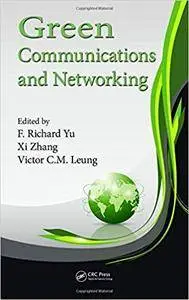F. Richard Yu, Xi Zhang, Victor C.M. Leung, "Green Communications and Networking"
2013 | ISBN-10: 1439899134 | 399 pages | PDF | 5 MB
2013 | ISBN-10: 1439899134 | 399 pages | PDF | 5 MB
Green Communications and Networking introduces novel solutions that can bring about significant reductions in energy consumption in the information and communication technology (ICT) industry―as well as other industries, including electric power. Containing the contributions of leading experts in the field, it examines the latest research advances in green communications and networking for next-generation wired, wireless, and smart-grid networks.
The book presents cutting-edge algorithms, protocols, and network architectures to improve energy efficiency in communication networks. It illustrates the various aspects of modeling, analysis, design, management, deployment, and optimization of algorithms, protocols, and architectures of green communications and networking. The text examines energy-efficient hardware platforms, physical layer, networking, and applications. Containing helpful references in each chapter, it also:
Proposes a mechanism for minimizing energy consumption of wireless networks without compromising QoS
Reviews recent development in utility communication networks, including advanced metering infrastructure and SCADA
Studies energy-efficient rate adaptation in long-distance wireless mesh networks
Considers the architectural design of energy-efficient wireline Internet nodes
Presents graph-theoretic solutions that can be adopted in an IP network to reduce the number of links used in the network during off-peak periods
Outlines a methodology for optimizing time averages in systems with variable length frames
Details a demand-based resources trading model for green communications
The book introduces a new solution for delivering green last-mile access: broadband wireless access with fiber-connected massively distributed antennas (BWA-FMDA). It also presents a methodology for optimizing time averages in systems with variable length frames. Surveying a representative number of demand and response methods in smart grids, the text supplies you with the understanding of smart grid dynamics needed to participate in the development of next-generation wireless cellular networks.



